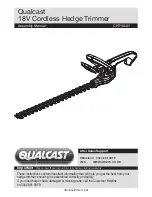
11
WARNING
○
Blade thrust may occur when the spinning blade contacts
a solid object in the critical area.
A dangerous reaction may occur causing the entire unit
and operator to be thrust violently. This reaction is called
blade thrust. As a result, the operator may lose control
of the unit which may cause serious or fatal injury. Blade
thrust is more likely to occur in areas where it is di
ffi
cult
to see the material to be cut.
○
If cutting attachment should strike against stones or
other debris, stop the engine and make sure that the
attachment and related parts are undamaged.
Stopping (Fig. 20)
Decrease engine speed and run at an idle for a few minutes,
then turn o
ff
ignition switch (23).
WARNING
A cutting attachment can injure while it continues to spin
after the engine is stopped or power control is released.
When the unit is turned o
ff
, make sure the cutting
attachment has stopped before the unit is set down.
Throttle adjustment knob (Fig. 21)
The cutting blade speed setting for when the throttle trigger
is fully pulled can be adjusted.
To increase the speed setting, turn the throttle adjustment
knob (27) clockwise, and to decrease the speed setting, turn
the knob counter-clockwise.
WARNING
○
While operating the tool, do not make adjustments using
one hand.
○
Hold the tool securely and pull the throttle trigger while
ensuring that the cutting blade is not touching the ground
or any objects.
MAINTENANCE
MAINTENANCE, REPLACEMENT OR REPAIR OF THE
EMISSION CONTROL DEVICES AND SYSTEMS MAY
BE PERFORMED BY ANY NON-ROAD ENGINE REPAIR
ESTABLISHMENT OR INDIVIDUAL.
Carburetor adjustment (Fig. 22)
The carburetor is a precision part that mixes air and fuel, and
it is designed to ensure high performance from the engine.
Before the tool is shipped from the factory, its carburetor is
adjusted during a test run. Only make adjustments if it is
necessary because of environmental conditions (the climate
or atmospheric pressure), the type of fuel, the type of two-
cycle oil, etc.
WARNING
○
Because the carburetor is manufactured with a high
degree of precision, do not disassemble it.
○
For this product, the only setting of the carburetor that
can be adjusted is the idle speed (T).
○
Never start the engine without the complete clutch cover
and tube assembled! Otherwise the clutch can come
loose and cause personal injuries.
T = Idle speed adjustment screw.
Idle speed adjustment (T)
WARNING
○
When the engine is stopped, do not excessively turn
the idle speed adjustment screw (T) in a clockwise
direction. Otherwise, when the engine starts, the cutting
attachment may unexpectedly rotate and cause an
injury.
○
Do not adjust the idle speed adjustment screw (T) for
any reason other than to adjust the idling.
Run the engine while adjusting the idling.
(1) If the engine stops during idling
Start the engine, and slowly turn the idle speed
adjustment screw (T) in a clockwise direction until it is in
a position at which the engine rotates smoothly. At that
time, ensure that the cutting attachment is not spinning.
(2) If the cutting attachment rotates during idling
Slowly turn the idle speed adjustment screw (T) in a
counter-clockwise direction until it is in a position at
which the cutting attachment does not rotate. At that
time, ensure that the rotation of the engine is smooth.
WARNING
If the cutting attachment still rotates after adjustment of
the idle speed adjustment screw (T), immediately stop
the engine and cease use, then contact the nearest
Hitachi Authorized Service Center.
Air
fi
lter (Fig. 23)
The air
fi
lter (28) must be cleaned from dust and dirt in order
to avoid:
○
Carburetor malfunctions.
○
Starting problems.
○
Engine power reduction.
○
Unnecessary wear on the engine parts.
○
Abnormal fuel consumption.
Clean the air
fi
lter daily or more often if working in
exceptionally dusty areas.
Loosen the screw (29), then open the air
fi
lter cover and
remove the air
fi
lter (28). Rinse it in warm soap suds.
Check that the
fi
lter is dry before reassembly.
An air
fi
lter that has been used for some time cannot be
cleaned completely. Therefore, it must regularly be replaced
with a new one. A damaged
fi
lter must always be replaced.
Fuel
fi
lter (Fig. 24)
Remove the fuel
fi
lter (30) from the fuel tank, and replace it if
it is dirty.
NOTE
A blocked fuel
fi
lter (30) can prevent the supply of fuel and
cause a rotation malfunction of the engine.
Spark plug (Fig. 25)
The spark plug condition is in
fl
uenced by:
○
An incorrect carburetor setting.
○
Wrong fuel mixture (too much oil in the gasoline)
○
A dirty air
fi
lter.
○
Hard running conditions (such as cold weather).
These factors cause deposits on the spark plug electrodes,
which may result in malfunction and starting di
ffi
culties. If
the engine is low on power, di
ffi
cult to start or runs poorly at
idling speed, always check the spark plug
fi
rst.
If the spark plug is dirty, clean it and check the electrode
gap. Re-adjust if necessary. The correct gap is 0.6 mm. The
spark plug should be replaced after about 100 operation
hours or earlier if the electrodes are badly eroded.
NOTE
In some areas, local law requires using a resistor spark
plug to suppress ignition signals. If this machine was
originally equipped with resistor spark plug, use same
type of spark plug for replacement.
Gear case (Fig. 26)
Check gear case or angle gear for grease level about every
50 hours of operation by removing the grease
fi
ller plug on
the side of gear case.
If no grease can be seen on the
fl
anks of the gears,
fi
ll the
gear case with quality lithium based multipurpose grease up
to 3/4. Do not completely
fi
ll the gear case.
000Book̲CG24EC(S).indb 11
000Book̲CG24EC(S).indb 11
2016/04/07 14:55:24
2016/04/07 14:55:24






































